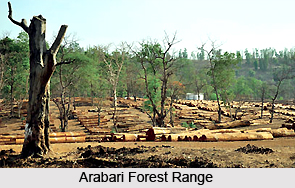 Arabari forest Range is the one in West Midnapore district of West Bengal, India contiguous with the Dalma range of East Singhbhum, Jharkhand. In the late 1960s and early 1970s, the political atmosphere in parts of the eastern state of West Bengal was tense. There was tremendous pressure on the state forests. Communities had no alternative but to cut trees to meet their basic needs. The forest department of the state sought police support to protect remaining forests, but they were met with considerable resistance from the local communities. Violent confrontations even resulted in deaths on both sides. The situation was especially volatile in Purulia district, where several
Arabari forest Range is the one in West Midnapore district of West Bengal, India contiguous with the Dalma range of East Singhbhum, Jharkhand. In the late 1960s and early 1970s, the political atmosphere in parts of the eastern state of West Bengal was tense. There was tremendous pressure on the state forests. Communities had no alternative but to cut trees to meet their basic needs. The forest department of the state sought police support to protect remaining forests, but they were met with considerable resistance from the local communities. Violent confrontations even resulted in deaths on both sides. The situation was especially volatile in Purulia district, where several
The centre of the range is 30 km from Midnapore town. The predominant tree of the forest is sal. A number of elephants also travel down from the Dalma range into Arabari and often encroach and attack villages in West Midnapore. The forest can be classified as part of the Upper Gangetic Plains moist deciduous forests. Arabari is notable as being the location of the first Joint Forest Management scheme in Indian started in 1971 by the forest officer, A.K. Banerjee.
At around this time, in the Arabari range of Midnapore district in southwest Bengal, an Indian Forest Service officer had started several experiments on some plots. Local communities often trespassed upon these plots, in their search for fuel wood, and for cattle grazing. The officer, realizing that fences alone would not work, began discussions and negotiations with communities of eleven villages surrounding the Arabari forest experimentation area. An informal agreement was reached which benefited both the parties. Villagers would have to stop grazing and grass-cutting on the field plots and in nearby areas. In return, they would get 25 per cent of revenues from the sale of timber from these plots and all rights to non-timber forest products. A comprehensive employment programme was also offered to the communities by involving them in plantation work. This agreement paved the way for natural regeneration, resulting in substantial increase in biomass productivity and enhanced availability of fuel, fodder, fiber and other non-timber forest products. With this, the first forest protection group in West Bengal recognized by the Forest Department was formed. This was in 1972. More such informal arrangements started emerging in other parts of West Bengal in the Arabari, Midnapur, Bankura and other Purulia districts.
Inspired by these successes, the late 1970s saw several villages in southwest Bengal starting to deal with the forest management crises on their own. They started taking care of small tracts of degraded forest. People cutting trees were stopped by village volunteers. Repeated offenders were fined, and outsiders were not allowed to cut trees. Throughout the1980s the Forest Department informally supported these efforts and encouraged formation of Forest Protection Committees (FPCs). The number of functional FPCs climbed steadily from fewer than 50 in 1985 to around 2,000 in 1990. In 1989, the West Bengal government issued a resolution legitimizing Joint Forest Management (JFM). Drawing on the Arabari experience, the resolution encouraged villagers and the Forest Department to work collaboratively to conserve and sustainable.



















